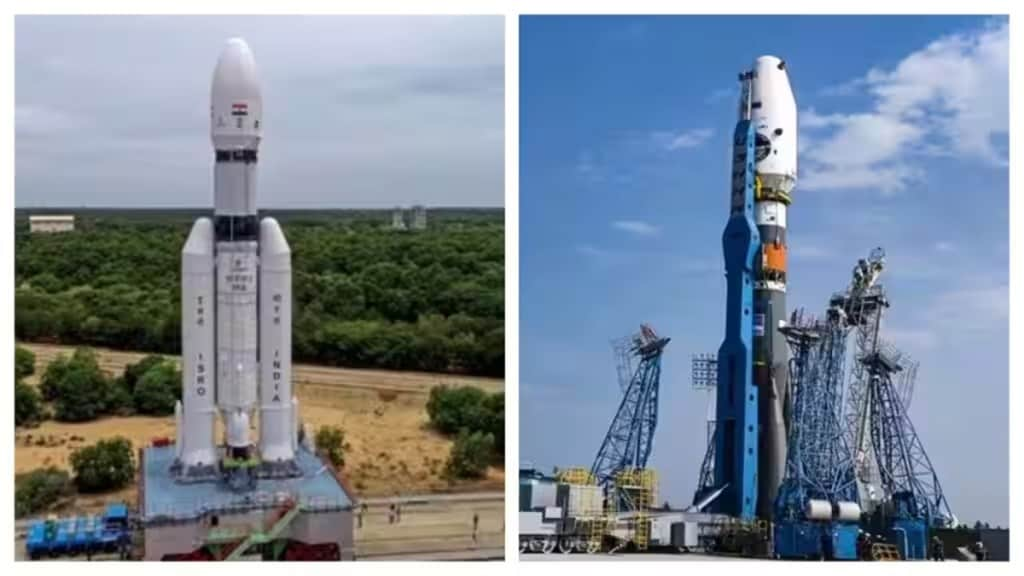The race to reach the uncharted south pole of the Moon is accelerating, as India’s Chandrayaan-3 and Russia’s Luna-25 are all geared up for their respective lunar landings in the coming week. These missions, without a doubt, carry significant implications beyond the thrilling competition in the celestial skies.
Chandrayaan-3 vs Luna-25: What is the aim/objective of both missions?
The Luna 25 mission, as outlined by the United States space agency National Aeronautics and Space Administration (NASA), seeks to investigate the makeup of the lunar polar regolith (surface material) and examine the plasma and dust constituents present within the lunar polar exosphere.
The main objectives of Chandrayaan-3 are to demonstrate a safe and soft landing on the lunar surface, to demonstrate Rover roving on the moon, and to conduct in-situ scientific experiments. The primary objectives of this mission are to gauge the density of near-surface plasma, encompassing ions, and electrons, on the Moon. Concurrently, the Vikram lander’s payload will focus on monitoring seismic activity around the designated landing area, while the rover’s payload will delve into an in-depth examination of the elemental composition of lunar soil.
A race to remember
Chandrayaan-3 strives to make history as the first to reach the Moon’s south pole, while Luna-25’s rapid trajectory has recently captured the spotlight among experts, drawing heightened global interest, particularly due to their closely scheduled landing windows: Luna-25 aiming for August 21-23, and Chandrayaan-3 targeting August 23-24.
Chandrayaan-3, a vital part of India’s lunar exploration series, embarked on its journey on July 14 this year, successfully entering lunar orbit on August 5. It is meticulously fine-tuning its orbit, diligently preparing for a soft landing attempt, all within a remarkable 40 days from launch.
Why are both missions important?
Luna 25 signifies Russia’s resurgence in lunar exploration, marking its return after a 47-year hiatus and aiming to reestablish its legacy in the realm of space exploration.
Chandrayaan-3, on the other hand, represents India’s third lunar mission and its second endeavor to achieve a gentle lunar surface landing.
In the grand scheme of cosmic exploration, the order of arrival may not dramatically alter the lunar landscape. However, each mission will contribute valuable knowledge about the Moon’s past and potential.
While the lunar south pole presents formidable landing challenges due to its rugged terrain, it remains an immensely coveted destination. Scientists speculate that this region may hold significant deposits of ice, which could prove invaluable for extracting fuel, oxygen, and even potable water.
Arrival time is more crucial for Chandrayaan-3
August 23 marks the beginning of daylight on the Moon. A lunar day, equivalent to roughly 14 Earth days, provides continuous sunlight. The instruments aboard Chandrayaan-3 have a limited operational span, restricted to one lunar day or 14 Earth days, due to their reliance on solar power, which necessitates sunlight for functionality.
During the lunar night, the Moon experiences extreme cold, plummeting to temperatures well below minus 100 degrees Celsius. Electronics not designed for such frigid conditions can freeze and become inoperative.
For the purpose of maximizing observation and experimentation opportunities, it is essential that Chandrayaan-3 lands at the commencement of the lunar day. If, for any reason, a landing attempt on August 23 is unfeasible, an alternative attempt is scheduled for the following day. If that too proves unattainable, the mission would await the conclusion of one full lunar month, approximately 29 days, for both the lunar day and night cycles to conclude.
In essence, Chandrayaan-3 cannot land before August 23 and prefers not to do so after August 24.
In contrast, Luna 25 faces no such constraints. It also relies on solar power, but it possesses an onboard generator to supply heat and power to its instruments during the lunar night. With a mission life span of a year, the choice of its landing date is not restricted by lunar sunlight availability.
Who will win?
One key factor influencing the differing arrival times of these missions is their mass and fuel efficiency. Luna-25 has a leaner lift-off mass of only 1,750 kilograms, significantly lighter than Chandrayaan-3’s 3,800 kg. This reduced mass allows Luna-25 to accelerate more effectively. Additionally, Luna-25’s surplus fuel storage eliminates fuel efficiency concerns, enabling it to take a more direct route.
As the world watches, both India and Russia are on the verge of historic achievements, shaping the course of humanity’s quest to uncover the Moon’s secrets. Both missions are expected to provide groundbreaking insights into the Moon’s composition, history, and potential as a resource-rich body.
Chrisphin Karthick, scientist at Bangalore’s Indian Institute of Astrophysics, told PTI that the competition to reach the lunar south pole fosters a dynamic environment where nations learn from each other’s achievements and setbacks, igniting innovation and pushing the boundaries of space exploration collectively.
The lunar south pole is of particular interest due to its potential water resources and unique geological features. This relatively unexplored region holds significance for future lunar missions, including NASA’s upcoming Artemis-III mission, which aims to carry humans to the Moon after a five-decade hiatus.
Former ISRO chairperson Dr K Sivan told PTI that the findings from these missions will enrich our understanding of the lunar environment and pave the way for future lunar exploration endeavors. He said that each mission holds the potential for groundbreaking scientific experiments that will expand our knowledge of the Moon’s mysteries and advance our capabilities in space exploration.
(With Agency Inputs)

